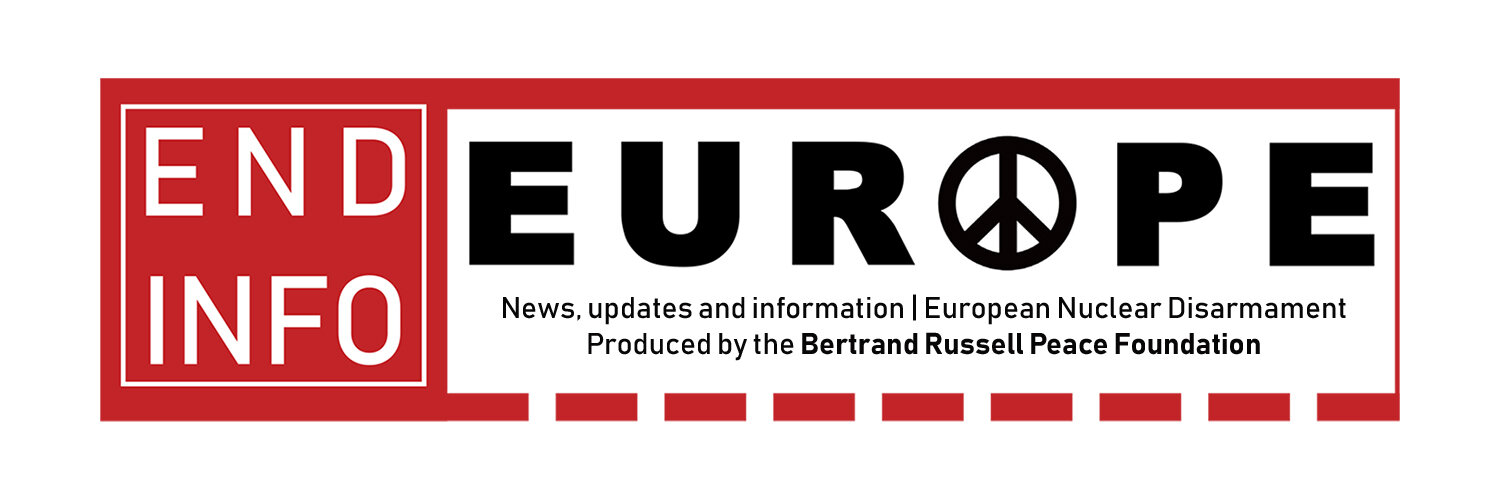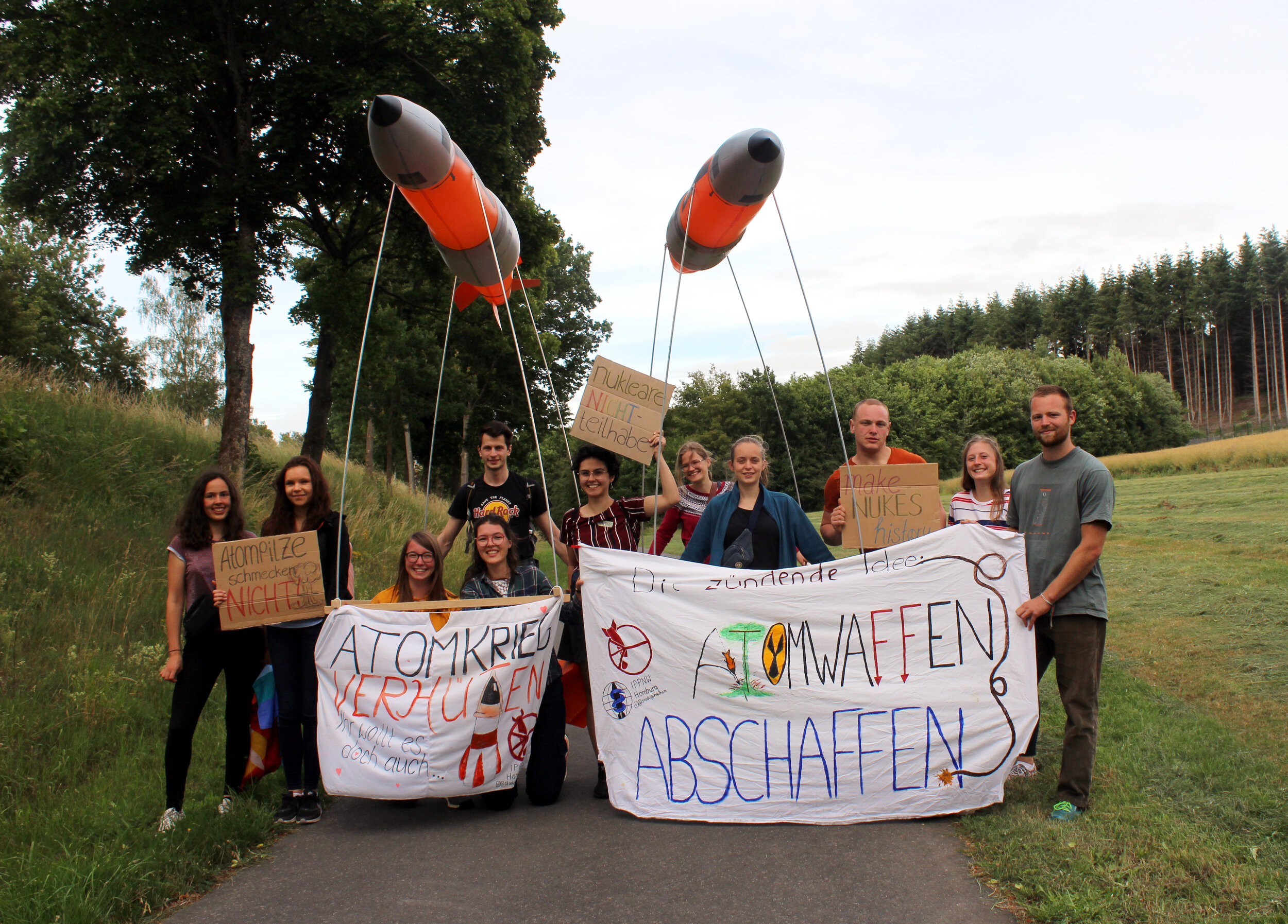The Bertrand Russell Peace Foundation launched the following statement in late 2018. Add your name to the statement here.
President Trump’s threat that the United States will withdraw from the Intermediate-Range Nuclear Forces (INF) Treaty undermines peace and security in Europe, as the European Union has quickly made clear.
The INF Treaty, signed by Presidents Gorbachev and Reagan in 1987, bans all ground-based missiles – nuclear and conventional – with ranges between 500 and 5500km. It addresses the risk of ‘limited' nuclear war, which sparked a Europe-wide movement of opposition and in favour of a nuclear weapons free zone in Europe, as expressed in the European Nuclear Disarmament (END) Appeal of 1980.
The END Appeal specifically sought the removal of medium range mobile nuclear weapons, deployed on Soviet territory and by the United States at bases in six European NATO member countries, in order to save the continent from becoming a nuclear battleground. It warned ‘we are entering the most dangerous decade in human history'. Appallingly, danger intensifies again. In January, the Bulletin of the Atomic Scientists moved forward the hands of the ‘Doomsday Clock’ to two minutes to midnight. As the year draws to a close, President Trump’s announcement drives the world nearer to the nuclear precipice.
We call on everyone concerned with peace and security to join in raising the alarm over the likely consequences of scrapping the INF Treaty and to work towards the creation of more Nuclear-Weapons-Free-Zones, including in Europe. These efforts will complement existing global disarmament initiatives, including the Treaty on the Prohibition of Nuclear Weapons, recently agreed at the United Nations.
Initial signatories:
Noam Chomsky, USA
Commander Robert Green RN (ret'd), New Zealand
Commander Robert Forsyth RN (ret'd), UK
Members of Parliament:
Ronnie Cowan MP, Scotland
Caroline Lucas MP, UK
Chris Williamson MP, UK
Sadet Karabulut MP, Netherlands
Members of the European Parliament:
Catherine Rowett MEP, UK
Julie Ward MEP, UK
Michèle Rivasi MEP, France
Jill Evans MEP, Wales
Sabine Lösing MEP, Germany (retired)
Stelios Kouloglou MEP, Greece
Kateřina Konečná MEP, Czech Republic
Lynn Boylan MEP, Ireland
Marie-Pierre Vieu MEP, France
Helmut Scholz MEP, Germany
Merja Kyllönen MEP, Finland
Nikolaos Chountis MEP, Greece
Marie-Chrisitne Vergiat MEP, France
Dennies de Jong MEP, Netherlands
Martina Michels MEP, Germany
Anne-Marie Mineur MEP, Netherlands
Trade Unionists:
Mark Serwotka, General Secretary, PCS Union, UK
Kevin Courtney, Joint General Secretary, National Education Union, UK
Louise Regan, Ex-President National Union of Teachers, UK
Peace movement/campaigners:
Kate Hudson, General Secretary, CND, UK
Reiner Braun, International Peace Bureau, Germany
Ken Fleet, Secretary Bertrand Russell Peace Foundation and Secretary of the original END Liaison Committee, UK
Paul Parker, Quakers in Britain, UK
Stuart Holland, Professor of Economics and Editor of the original END Bulletin, Portugal
Kristine Karch, Co-Chair International Network No to war - no to NATO, Germany
Dave Webb, Chair, Campaign for Nuclear Disarmament, UK
Joseph Gerson, Campaign for Peace Disarmament and Common Security, USA
Ray Perkins Jr., Professor of Philosophy, emeritus, Plymouth State University and vice chairman of the Bertrand Russell Society board of directors, USA
Steven Rose, Emeritus Professor of Neuroscience, Open University, UK
Tony Simpson, Bertrand Russell Peace Foundation, UK
Tamara Tura Coates, Bertrand Russell Peace Foundation, UK
Tom Unterrainer, Bertrand Russell Peace Foundation, UK
Lucas Wirl, Executive Director International Association of Lawyers Against Nuclear Arms, Germany
Peter Kennard, Professor of Political Art, Royal College of Art, UK
Rae Street, Greater Manchester & District CND, UK
Jérôme Peraya, Agir pour la Paix, Belgium
Gerd Berlev, It's time for peace - action against war, Denmark
Jeff Hoffman, Tavolo per la Pace della Val di Cecina, Italy
John Hallam, People for Nuclear Disarmament, Australia
Brian Jones, CND Cymru, Wales
Philip Austin, Coordinator, Northern Friends Peace Board, UK
Bianca Todd, Granddaughter of Ron Todd and Founder of the Ron Todd Foundation, UK
Peter Murphy, Secretary, Sydney Peace & Justice Coalition, Australia
Panos Trigazis, President of the Observatory of International Organisations and Globalisation, Greece
Maria Arvaniti-Sotiropoulou, President of International Physicians for the Prevention of Nuclear War (Greek Section) and Representative in Greece of the International Campaign to Abolish Nuclear Weapons (ICAN), Greece
Kees Kalkman, Anti-Militaristies OnderzoeksKollektief - VD Amok, Netherlands
Takao Takahara, Peace Depot, Japan
Andreas Bieler, Professor of Political Economy, University of Nottingham, UK
Dr Tim Street, academic and peace activist, UK
Susie Ventris-Field, Welsh Centre for International Affairs, Wales
Manuel Pardo, Frente Antiimperialista Internacionalista, Spain
Ria Verjauw, Belgian Coalition 'stop uranium wapens', Belgium
Yuko Matsubara, Sayonara Nukes Belgium/representative, Belgium
Maria Van Doren, Peace Movement, Women in Black, ICM, Belgium
Tine Seaux, Leuvense Vredesbewegingen, Belgium
Gérard Lévy, Europe Écologie Les Verts (commission paix et désarmement), France
Daniel Durand, Director of the Institute of Documentation and Research for Peace, France
Michel Thouzeu, Mouvement de la Paix secretariat national, France
Patrice Salzenstein, National Bureau Member, Mouvement de la Paix, France
Régine Minetti, National Bureau Member, Mouvement de la Paix, France
Jean-Marie Borgraeve, Union Pacifiste, France
Groupe Non-Violent Louis Lecoin, France
Jacques Veron-Bocquel, Ligue des Droits de l'Homme, Caen, France
Dominique Lalanne, Abolition des Armes Nucleaires, France
Annie & Joel Frison, Mouvement de la Paix, comité de Bourges et du Cher, France
Élise Bourdier, Mouvement de la Paix, France
Bernard Revollon, Mouvement de la Paix Bas-Rhin, France
Lisa Silvestre, Mouvement de la Paix, France
Dominique Duneau, Mouvement de la Paix, France
Jean-claude Bourguignon, Mouvement de la Paix, France
Gilles Auger, Mouvement de la Paix, Bourges, France
Anne-Marie Clausse, Mouvement de la Paix, France
Jean Arlette, Conseill déléguée Isère, France
Albert Martinand, Mouvement de la Paix, France
Hubert Jaussaud, Mouvement de la Paix, France
Marie-Madeleine Rajau, Mouvement de la Paix, France
Jeannine Orset, Mouvement de la Paix, France
Pierre Orset , Mouvement de la Paix, France
Jean Paul Menou, Mouvement de la Paix du Nord Finistère, France
Daniel Claeysen, Mouvement de la Paix, France
Denise Tardy, Mouvement de la Paix, France
Edith Boulander, Mouvement de la Paix, France
Yves Derriennic, Mouvement de la Paix, France
J M Paoli, Mouvement de la Paix, France
Pierre-Olivier Poyard, Mouvement de la Paix, France
Dany Limousin, Mouvement de la Paix, France
Stuart Hartill, Co-ordinator of Shee Nish! (Peace Now!), Isle of Man
Enrique Santiago, General Secretary, Communist Party of Spain
Manu Pineda, Head of International Relations, Communist Party of Spain
Benjamin Regonesi, Communist Party of France, France
Jan Hellebaut, Aktie Vredesbelasting, Belgium
Pierre Flament, Mouvement de la Paix, France
Bram Vranken, Vredesactie, Belgium
Anna Lucia Rocca, Italy
Willy Meyer, Asociacion Marcos Ana, Spain
Bruce Kent, CND Vice Predisent, UK
Myrsini Athanassiadou, Popular Unity, Greece
Mark Ingram, Treasurer British Pugwash Trust, UK
TJ Milburn, Chair, Exeter CND, UK
Rev Christopher Harrison, St Peter's and All Saints, Nottingham, UK
E. Martin Schotz, MD, Coordinator, Peace Task Force, Franklin County Continuing the Political Revolution, USA
Andre Sheldon, Director, Global Strategy of Nonviolence, USA
Mikael Böök, Finland
Barbara Laxon, USA
Douglas Renick, USA
Wolf Goehring, Scientist, Germany
Alain Limousin, France
Daniel Salhorgne, France
Pierre Flament, France
Elisabeth Grand, France
Raphael Porteilla, France
Daniel Deprez, France
Marie-France Coullet, France
Ulla Grant, CND Member, UK
Ian Hewitt, Unite the Union (personal capacity), UK
Margie Doyle Papadopoulou, Greece
Colin Clarke, UK
Joan Edenburg, Netherlands
Till Geiger, UK
David Browning, UK
Brian Winters, fastforpeace.org, USA
Alfie Newman, UK
Safar Yusuf, UK
Debra Urbacz, UK
Paul Russell, UK
Cari Spokes, UK
Adrian Rupp, UK
Patrick Hublou, UK
Laurence Chisholm, UK
David Fitzpatrick, Green Party, UK
Pat Sanchez, Secretary, Rochdale and Littleborough Peace Group, UK
Mark Hollinrake, Green Party, UK
Simon Koreshoff, UK
Christine Bousfield, UK
Marta Bascuñana, Spain








